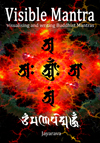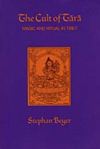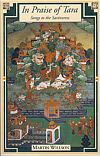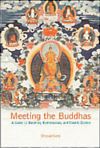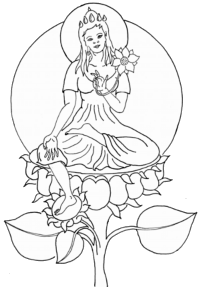

ā rya tā rā
The Bodhisattva Tārā was born from the tears of Avalokiteśvara as he looked down on the sorrows of the world. Her name comes from the Sanskrit word Tāra and means literally: carrying across, a saviour, protector; a star, shining. Tārā is usually depicted with the Tathāgata Amitabha in her headress. Green Tārā is also sometimes called Ārya or Noble Tārā. In Tibetan she is Drolma (sgrol ma).
Despite the connection with the Padma family via Amitabha and Avalokiteśvara, she is also considered member of Amoghasddhi's Vishvavajra family, as she appears as his consort or prajñā in yab-yum (father-mother) depictions.
Her right hand is in the mudra of giving, and her left hand the mudra of fearlessness through going for refuge to the three jewels. Her left leg is tucked up in the meditation posture and her right leg is stepping down into the world. The left leg symbolises her meditation, while the right symbolises her compassionate activity in the world.
White Tārā is the most common form of Tārā after green.
Other prajñās: Locanā | Māmaki | Paṇḍāravāsinī; | Ākāśadhātvīśvarī
Seed syllable
 Siddhaṃ |
The seed Syllable of the Tārā's is tāṃ There is an interesting relationship between the body of White Tārā, and the form of the tāṃ in the Siddhaṃ script which you can read about on White Tara, tāṃ, and the Mandala. |
 Tibetan - Uchen (from Rivendell Retreat Centre) |
mantra
Siddhāṃ

Tibetan

Lantsa

Lantsa text by Scott Forland
Transliteration
oṃ tā re tu ttā re tu re svā hā
oṃ tāre tuttāre ture svāhā
Notes on the Tārā mantra
Tāre is the feminine vocative of Tārā's name and is therefore a call to her by name: "Oh Tārā!". Tu can mean "to be strong, or to have authority; to make strong or efficient; to be able; or it can mean pray!, I beg, do, now, then"; and is also sometimes used as an expletive. So Tuttāre could be "Oh Tārā be strong", or "Oh Strong Tārā". There is a Sanskrit word tura which means "quick, willing, prompt", and ture would be that word in the feminine vocative: Oh (she who is) quick, willing etc., which would fit the mythology of Tārā.
A traditional explanation of the mantra is that tāre represents deliverance from mundane suffering; while tuttāre represents deliverance into the spiritual path conceived in terms of individual salvation; and finally ture represents the culmination of the spiritual path in terms of deliverance into the altruistic path of universal salvation.
Wayman quotes an explanantion the Kusumāñjali-guhyasamāja-nibandha-nāma by Ratnākaraśānti (a commentary on the Guhyasamāja Tantra) :
"tāre (O Tārā) because she rescues by bring to the other side (i.e. is the pāramita). Now tud- is pain; tuttā, suffering; tuttāre (O Tārā, from suffering), because she rescues from pain. Then ture (O Turā, the fast one), because she is fast, i.e. rescues speedily.
Wayman, A. "The Significance of Mantras from the Veda Down to Buddhist Tantric Practice," in Wayman, A. Buddhist Insight. Dehli: Motilal Banarsidas, 1984. p.427-8.
For more info on Tārā see the article by Dharmacari Purna in the Western Buddhist Review
See Also the Wildmind.org page on the Tārā Mantra.

